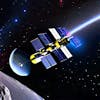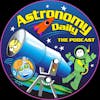S03E33: Farewell CloudSat & The Tale of Earth's Quasi-Moon

Embark on a celestial voyage with host Anna in today's episode of Astronomy Daily - The Podcast, where we bid a fond adieu to NASA's CloudSat mission after nearly two decades of revolutionizing our understanding of Earth's atmosphere. As we marvel at...
Embark on a celestial voyage with host Anna in today's episode of Astronomy Daily - The Podcast, where we bid a fond adieu to NASA's CloudSat mission after nearly two decades of revolutionizing our understanding of Earth's atmosphere. As we marvel at the legacy of this Earth-observing pioneer, we then set our sights on the mysterious quasi-moon Kamoʻoalewa, unearthing its lunar origins and what it reveals about the moon's violent past.
The episode continues with a salute to China's Shenzhou 18, marking over twenty years of the nation's human spaceflight endeavors, and the ongoing expansion of its celestial ambitions with the Tiangong space station. As we celebrate the technological triumphs of China's space program, we also commemorate the Hubble Space Telescope's 34th anniversary with a breathtaking image of the Little Dumbbell Nebula, a cosmic canvas of stellar demise and rebirth.
Finally, we gear up for the historic launch of Boeing's Starliner, joining the mission's crew as they begin their quarantine countdown to a groundbreaking journey to the International Space Station. With every meticulous preparation, we witness the harmony of human and technological collaboration in the pursuit of the stars.
Join us for a stellar odyssey that not only illuminates the achievements of our spacefaring past but also ignites the dreams of our interstellar future. This is Astronomy Daily - The Podcast, where every episode is a step further into the infinite expanse of the universe.
---
**Featured Topics:**
1. **NASA's CloudSat Finale:** Celebrating the end of a pioneering Earth-observing mission that has reshaped our knowledge of the atmosphere.
2. **Secrets of Kamoʻoalewa:** Unraveling the lunar lineage of Earth's quasi-moon and its implications for planetary defense.
3. **China's Shenzhou 18 Milestone:** Reflecting on two decades of human spaceflight and the nation's celestial palace, Tiangong.
4. **Hubble's Anniversary Portrait:** Admiring the Little Dumbbell Nebula's snapshot, a symbol of the telescope's enduring legacy.
5. **Starliner's Inaugural Crew:** Preparing for liftoff with Boeing's first crewed mission to the ISS, a new chapter in commercial spaceflight.
---
**Additional Information:**
For more cosmic content, visit astronomydaily.io, where you can dive into our episode archive, sign up for our free newsletter, and engage with our space-loving community. Follow us on X (@AstroDailypod) for the latest updates, and if today's journey has sparked your curiosity, share the episode with others to spread the stellar joy. Until our next celestial encounter, this is Anna, reminding you to keep your gaze skyward and your spirit of exploration alive. Clear skies and boundless curiosity to all our fellow stargazers!
**Host Sign-off:** Anna: As we conclude today's cosmic journey, I'm Anna, thanking you for joining us on Astronomy Daily - The Podcast. Remember, the universe is brimming with stories, and we're here to tell them. Visit astronomydaily.io for more, and until next time, keep looking up and dreaming big. Clear skies and cosmic dreams to all.
This episode is brought to by NordPass, the password manager you need to help make life less stressful. To take up out stellar deal, visit www.bitesz.com/nordpass
Become a supporter of this podcast: https://www.spreaker.com/podcast/astronomy-daily-the-podcast--5648921/support.
AI Transcript
Astronomy daily podcast celebrates end of NASA's cloudsat mission
Anna: Hello, and welcome to Astronomy Daily, the podcast, your gateway to the cosmos and the latest in space exploration. I'm Anna, your host, guiding you through the stars and beyond as we discuss the remarkable stories our universe has to share. Today's episode promises a journey through a collection of tantalizing astronomical developments. We'll begin by bidding farewell to NASA's cloudsat, an Earth observing mission that has graced our skies for nearly two rich and informative decades. Next, we'll venture closer to Earth, or should I say Earth's quasi moon Kamo Oalewa, to unravel the secrets of its lunar lineage. The stellar achievements continue with an update on China's Shenzhou 18, a testament to over two decades of committed human spaceflight by the nation. Then we will commemorate the 34th anniversary of the Hubble space Telescope with a visual feast, the little dumbbell nebula captured in a snapshot that continues to stretch the boundaries of our imagination. Lastly, we prep for liftoff with the first crew of Boeing Starliner as they embark on a rigorous quarantine protocol ahead of their historic journey to the International Space Station. Strap in and ready your telescopes. We're about to embark on a stellar odyssey. This is astronomy daily, the podcast. Execute your astronaut, the astronomy Daily podcast after nearly 18 remarkable years aloft tirelessly surveying the structure and fabric of Earth's cloudy mantle, NASA has officially brought an end to its groundbreaking cloudsat mission. Launched in April of 2006 on an expedition initially charted for just 22 months, this pioneering satellite far exceeded its proposed lifespan, deploying the first spaceborne 94 GHz cloud profiling radar. This technological marvel pierced through the cloud veil with a thousand fold more sensitivity than its terrestrial counterparts, revealing to us not merely flat representations of clouds but intricate three dimensional cross sections alive with ice and rain. Cloudsat's cutting edge observations have been instrumental in crafting a better understanding of precipitation patterns across our globe and the influence of cloud formations on Earth's atmospheric heating and cooling, the mission offered unprecedented insights into the inner workings of formidable weather systems, including hurricanes Maria, Harvey and Sandy, shedding light on the mechanics of their growth and intensification. Yet with the cloud profiling radar turned off in December 2023 and the satellite's deliberate descent last month into a lower orbit for its eventual atmospheric reentry, we are reminded of the natural cycle of innovation and obsolescence. With Cloudsat's termination, a chapter in climatology closes, but its legacy continues to resonate through the wealth of data it has provided to scientists as it joins its sister satellite calypso in decommission the curtains draw on a truly synergistic dance in our skies, leaving behind a legacy steeped in a deeper cognizance of Earth's complex atmosphere.
Kamawalawa fragment likely blasted away from our moon by massive impact
Today, let's journey into the depths of space and uncover the secrets of Earth's quasi moon, Kamawalua. This intriguing celestial body, also designated as 469219 Kamawalawa, captured the curiosity of astronomers when it was first discovered in 2016, and since then, they've been piecing together its cosmic history. Recent studies suggest that Kamawalawa is a fragment, a sizable one, measuring between 131 to 328ft in width, which was likely blasted away from our moon by a colossal impact event. This dramatic collision is believed to have occurred between 1 million and 10 million years ago, leading to the creation of the 13.7 miles wide crater on the moon's surface. Known as Giordano Bruno, the composition of Kamaualawa closely resembles that of lunar rocks. Its peculiar orbit in lockstep with our Earth and its rapid spin hinted it wasn't an ordinary asteroid from the belt between Mars and Jupiter, but rather a piece of our very own moon. Through a blend of observation and complex computer modeling, researchers have reconstructed the cataclysmic cosmic crime scene, linking Kamawalua not just to the moon, but directly to the crater Giordano Bruno. This connection has profound implications not only for our understanding of the moon's history, but also for the broader Neo, or near Earth object population. It underscores the importance of planetary defense and the continued monitoring of neos, which could potentially threaten our planet. The discovery serves as a vivid reminder of the dynamic ballet of our solar system, an ongoing dance of creation and destruction. Over billions of years, China continues to soar to new heights beyond our atmosphere. The nation has embarked on its 13th foray into low Earth orbit, with Shenzhou 18 signifying over two decades of human endeavors in space. Since the inception of its space program, China has steadily established itself as a formidable presence in the extraterrestrial domain. This latest launch marks yet another milestone, highlighting its ambitious pursuit of celestial exploration and advancement. This mission is more than just a number. Half of these crewed sojourns targeted the Tiangong space station. Aptly named celestial palace. A, beacon of China's independent spacefaring capabilities, Tiangong serves as a testament to the country's scientific and engineering prowess. From the maiden voyage of Shenzhou one in November 1999 to the historical feat of sending the first chinese national, Yang Liwei, into space on Shenzhou five, China's trajectory has been genuinely stratospheric as we commemorate Shenzhou Eighteen's journey to the stars, we also acknowledge the relentless spirit and dedication that has propelled China to this momentous point in its spaceflight narrative. The echoes of the past vividly blend with the promise of tomorrow as each mission further cements China's role in the grand tapestry of space exploration, inspiring future generations of astronauts to gaze skyward and dream.
The Hubble Space Telescope marks 34 years orbiting Earth with stunning new image
The Astronomy Daily podcast as the Hubble Space Telescope marks a remarkable 34 years orbiting Earth, it presents us with a visual feast, a stunning snapshot of the little dumbbell nebula, nestled 3400 light years away in the constellation Perseus. This celestial wonder, also known as Messier 76 m m 76, or NGC 656 51, is a planetary nebula, a glowing testament to the final breaths of a dying red giant star. This star now collapses into a hot white dwarf, a cosmic cinder some 250,000 degrees fahrenheit in temperature. The little dumbbell nebula is a complex structure. At its heart, a ring of gas and dust ejected by the star now seen edge on. The intriguing suggestion is that a binary companion star shaped this ring prior to a potential cataclysmic absorption by its dying partner. A stark example of stellar cannibalism persevering through torrents of stellar wind, the red and blue hues of the nebula glow fiercely, a spectacle set by nitrogen and oxygen. The relentless winds travel so rapidly, they could traverse the distance from Earth to the moon in mere minutes. Yet the existence of the little dumbbell nebula is fleeting on the cosmic scale, set to vanish within 15,000 years. Reflecting on Hubble's rich history, this anniversary photograph is but one glimmer in its trove of over 1.6 million observations. It's a timely reminder of Hubble's role in transforming our comprehension of the universe, from the discovery of supermassive black holes to the mysteries of dark energy and the birth rate of planets. As Hubble continues its voyage into the unknown, it stands as a testament to human curiosity and the enduring quest to understand the stars.
The inaugural Boeing Starliner crewed mission is set for launch on Friday
The dawn of a new era in commercial spaceflight approaches as Boeing takes a giant leap forward with its Starliner spacecraft. The inaugural crewed mission, setting its sights towards the vast expanse of the cosmos, is poised for launch. Veteran NASA astronauts Barry, Butch Wilmore and SUNY Williams have commenced their standard pre flight quarantine, a vital measure to preserve the health and safety of the crew and those aboard the International Space Station. Their mission, recognized as the crew flight test, will break boundaries as they are set to become the first humans to be launched into space atop the power of a united launch alliance Atlas V rocket. This adherence to stringent quarantine protocols highlights the delicate balance between human exploration and the preservation of life on and off our planet. With a journey slated to commence from Kennedy Space center, there is an air of anticipation swirling through the aerospace community. The days leading up to this historic launch are packed with precision driven preparations and remote interactions, ensuring that when the moment arrives, the Starliner and its crew are ready to etch their names. In the annals of space travel, their saga of fortitude will be one of splendid isolation, reflective introspection, and ultimately, seamless integration with the orbital dance of the International Space Station. Scripted within the harmonious cooperation between engineers, scientists, and astronauts lies the story of humanity's relentless pursuit to explore the uncharted territories that lie beyond our terrestrial shores. As we stand on the precipice of the unknown, the journey of the Starliner's first crew undeniably marks a pivotal chapter in the unfolding narrative of space exploration.
To continue exploring space and staying current with astronomy news, visit our digital observatory
Exploration as we reach the Starlit conclusion of today's episode, I'd like to thank you for joining us on this odyssey through the cosmos. Remember, the journey doesn't end here. To continue exploring the expanse of space and staying current with astronomy news, visit our digital observatory at Astronomydaily IO. There you can sign up for our free daily newsletter to stay aligned with the celestial events and scientific revelations, listen to all our back episodes, and peruse sponsor links and special deals. We're always eager to hear from fellow stargazers, so don't hesitate to leave us a message with your thoughts, questions, or discoveries. Follow us on x, formerly known as Twitter strodailypod, to keep up with our updates and connect with our community. If the stars have aligned for you in today's episode, please share it with your friends and help spread the wonder. Until next time, this is Anna saying, keep your eyes on the skies and your curiosity boundless. Astronomy Day stories are told.
New to Astronomy Daily - The Podcast?
Here are some great episodes to start with.














